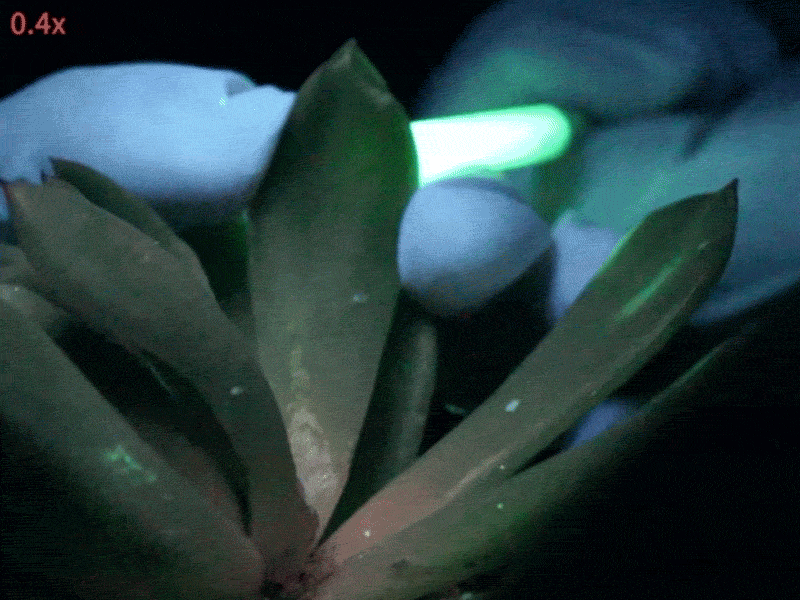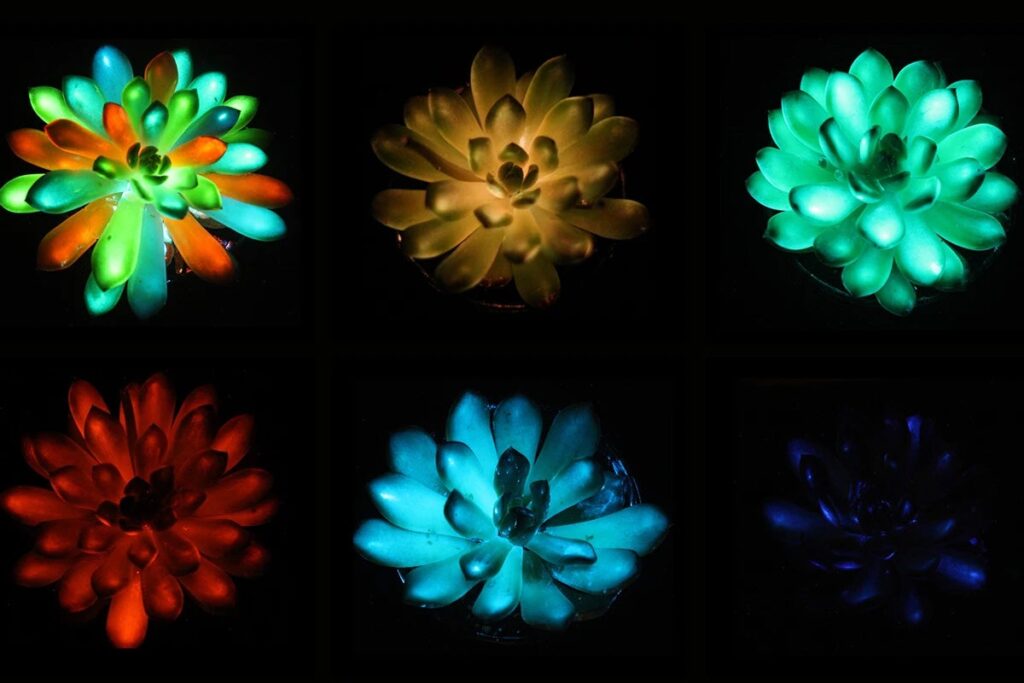August 28, 2025
3 min read
These Succulents Glow in the Dark—And They’re Gorgeous
Houseplants become rechargeable night-lights after injection with tiny phosphor particles
Researchers gave these succulents in the Echevaria genus a glow up by injecting them with luminescent particles.
University students might soon have something other than black-light posters to brighten their dorm rooms. Researchers have created glow-in-the-dark plants by injecting succulents with materials similar to those that make the posters light up. The fleshy plants shine as brightly as a night light, and can be made to do so in a wide variety of colours — a first for glowing houseplants, according to the team.
The researchers, led by Xuejie Zhang, a materials scientist at the South China Agricultural University in Guangzhou, describe today how they produced the plants in the journal Matter. They have applied for a patent on the technology, which they hope will lead to decorative installations and living lighting.
The idea of making glowing plants has captivated scientists since the late 1980s, when researchers made the first bioluminescent plant by inserting a gene from a firefly (Photinus pyralis) into a type of tobacco (Nicotiana tabacum). This work laid the foundation for the first genetically engineered luminescent houseplant to come on the market in the United States, last year. The biotechnology firm Light Bio in Sun Valley, Idaho, sells the petunia (Petunia hybrida), which glows a very faint green thanks to genes from a light-emitting mushroom.
On supporting science journalism
If you’re enjoying this article, consider supporting our award-winning journalism by subscribing. By purchasing a subscription you are helping to ensure the future of impactful stories about the discoveries and ideas shaping our world today.
Leafy greens … and blues and reds
Unlike the petunia, which emits light through chemical reactions in its cells, the succulent glows because of materials injected into its leaves. These materials — phosphor particles made of strontium and aluminium dosed with other metals — absorb energy from light at one wavelength, store some of that energy and then slowly re-emit it at a different wavelength for several hours. For instance, one material the scientists injected into their succulents absorbs ultraviolet and blue light, and re-emits it as green light.
This type of ‘afterglow’ phosphor is used in glow-in-the-dark toys and paints, and as an imaging tracer for laboratory animals. Whereas genetically engineered bioluminescent plants are, so far, limited in the range of colours they emit, afterglow phosphors span a wide variety of hues, including red and blue, and they can be combined to produce a white glow.

This video shows how the tiny phosphor particles spread through the succulent leaves after they are injected.
The researchers purchased phosphors containing strontium aluminate and ground them down to particles of various sizes before injecting them into an assortment of plants. They found that particles around 7 micrometres in diameter glowed more brightly than did nanoparticles in plants, and were able to fill up the interior tissues of succulent leaves for a stronger, more uniform glow. By contrast, plants with simple leaf structures, such as tobacco plants and pak choi, emitted a more patchy glow.
The plant favoured by the team is the succulent Echevaria ‘Mebina’, a common houseplant that grows rosettes of dense, fleshy leaves. To make every leaf glow, the researchers had to inject each one with phoshor particles, a process that takes about ten minutes. The luminescence — which the team generated in hues of blue-green, blue-violet, green, red and white — lasted as long as 120 minutes after exposing the plant to tailored wavelengths of light or sunlight, and could be triggered again and again over the 10 days of the study.
The researchers estimate that the cost of materials to create one plant is about 10 yuan (US$1.40).
Co-author Shuting Liu, also at the South China Agricultural University, says that the team hopes to move away from injecting each leaf by using smaller particles, which can spread more readily throughout plants. But the team will need to overcome an obstacle: the smaller the particle, the dimmer the glow.
Keith Wood, chief executive of Light Bio, says it’s not yet clear how these particles affect the health of the plants over their lifespan. Additionally, the researchers acknowledge that more safety testing is needed; in particular, they need to know whether a leaf full of particles would be toxic if accidentally ingested.
Wood is also sceptical that glowing plants will ever be a living lighting system, capable of replacing light bulbs. So far, researchers have fallen “spectacularly short of that objective”, he says. Instead, whimsy is the name of the game with these plants. “We’re making something fun, enjoyable, magical,” he adds.
This article is reproduced with permission and was first published on August 27, 2025.
It’s Time to Stand Up for Science
If you enjoyed this article, I’d like to ask for your support. Scientific American has served as an advocate for science and industry for 180 years, and right now may be the most critical moment in that two-century history.
I’ve been a Scientific American subscriber since I was 12 years old, and it helped shape the way I look at the world. SciAm always educates and delights me, and inspires a sense of awe for our vast, beautiful universe. I hope it does that for you, too.
If you subscribe to Scientific American, you help ensure that our coverage is centered on meaningful research and discovery; that we have the resources to report on the decisions that threaten labs across the U.S.; and that we support both budding and working scientists at a time when the value of science itself too often goes unrecognized.
In return, you get essential news, captivating podcasts, brilliant infographics, can’t-miss newsletters, must-watch videos, challenging games, and the science world’s best writing and reporting. You can even gift someone a subscription.
There has never been a more important time for us to stand up and show why science matters. I hope you’ll support us in that mission.

